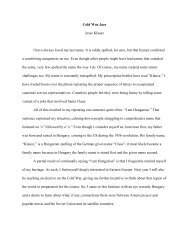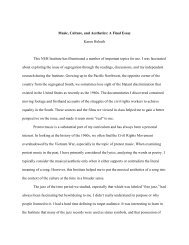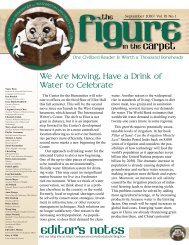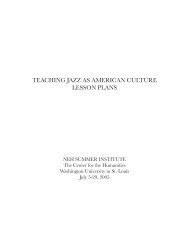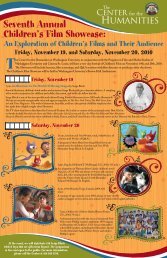Create successful ePaper yourself
Turn your PDF publications into a flip-book with our unique Google optimized e-Paper software.
130Mike Caddenalso makes a shift from audience to genre in one breath, blurring <strong>the</strong>distinction between <strong>the</strong>m. As if in response to Zohar Shavit’s claim that“writing for children usually means that <strong>the</strong> writer is limited in his optionsof text manipulation” (66), Paterson writes, “‘Don’t you feel constrictedwriting for children?’ <strong>the</strong>y’ll ask. William, don’t you find fourteen tightlyrhymed lines an absolute prison? Ah, Pablo, if you could just yank thatpicture off that lousy scrap of canvas! You get <strong>the</strong> point” (33). WhatPaterson <strong>and</strong> Lewis illustrate is that it is both easy <strong>and</strong> sensible to combine<strong>the</strong> notions of genre <strong>and</strong> audience when one is writing in a genre namedfor an audience—text <strong>and</strong> context become conflated. Genre <strong>and</strong> audienceare combined ra<strong>the</strong>r than confused with each o<strong>the</strong>r. <strong>The</strong>se authors haven’tmade an error; <strong>the</strong>y have made an erasure: <strong>The</strong>y erase <strong>the</strong> distinctionbetween audience <strong>and</strong> genre in children’s literature.Perhaps it isn’t odd to talk about genre as an audience. Genre is anaudience in its own way, an audience to which people write, a livingtradition with clear rules <strong>and</strong> expectations for discursive behavior. <strong>The</strong>dual audience in this case is composed of both children <strong>and</strong> traditionra<strong>the</strong>r than that of children <strong>and</strong> adults.<strong>The</strong> critic’s impulse, however, is to make a distinction betweencategories—between texts <strong>and</strong> contexts. Peter Hunt suggests that “<strong>the</strong>critic of children’s literature has only two choices”: She can ei<strong>the</strong>rdecontextualize <strong>the</strong> text by ignoring <strong>the</strong> audience, or she can grant <strong>the</strong>primacy of <strong>the</strong> audience as <strong>the</strong> foundation of <strong>the</strong> genre <strong>and</strong> communicateto that audience, however perceived (“Necessary Misreadings” 108).Hunt’s position is that <strong>the</strong>re is an absolute <strong>and</strong> necessary choice. Lewis’s<strong>and</strong> Paterson’s conflation show that such easy distinctions may be toocomplicated to count on, if not actually impossible.Respected critics can be as ambivalent about <strong>the</strong> differences betweentexts <strong>and</strong> contexts as successful authors. Peter Hollindale considers “<strong>the</strong>author’s textual negotiations with <strong>the</strong> child” (“Signs” 12) to be whatmakes children’s literature “unique, <strong>and</strong> different in kind from o<strong>the</strong>r formsof literature” (12), yet questions that negotiation when he says that “<strong>the</strong>adult children’s author is always obsolete” (22) <strong>and</strong> that “children” is“an increasingly unstable concept” (25). Jacqueline Rose maintains that“<strong>the</strong>re is no child behind <strong>the</strong> category ‘children’s fiction,’ o<strong>the</strong>r than <strong>the</strong>one which <strong>the</strong> category itself sets in place” (10), yet she is concernedabout <strong>the</strong> potential for unethical authorial control over real child readersthat might result in a sort of “molestation” (70). Barbara Wall notes that<strong>the</strong>re is a “substantial barrier of age” between adult writer <strong>and</strong> child readerthat “may be surmounted or traversed” but never removed (20). Does“traversing” <strong>the</strong> barrier mean that writers will “serve . . . <strong>the</strong>ir chosen



